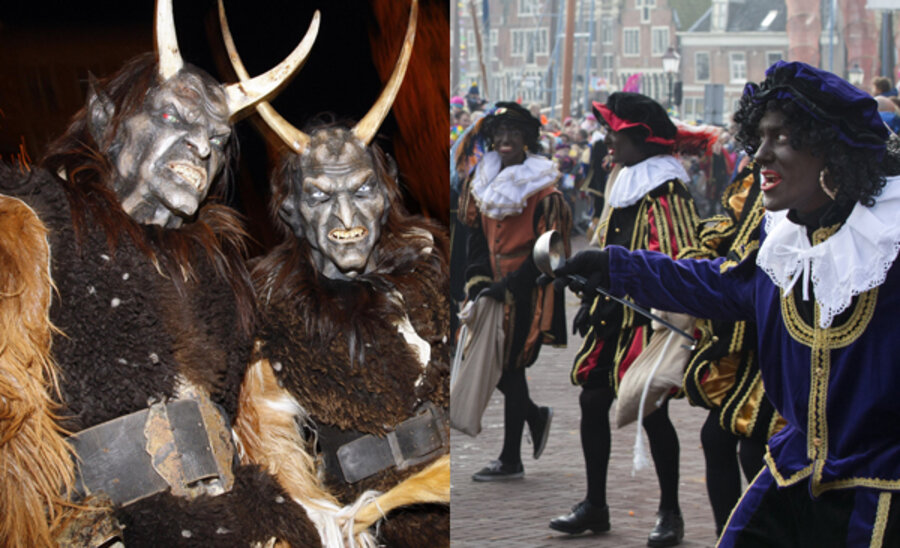Christmas in Europe? Prepare to be scared – or insulted.
Loading...
I love this time of year.
Not for the onset of winter weather, seasonal decorations, and seasonal cheer. Nor for the time off around the holidays. Not even for the opportunity for material indulgence via a blitz of shopping bargains.
No, I love this time of year because it means the arrival of Black Pete, Krampus, and a host of other unique European seasonal traditions that are closely tied to the traditional Santa Claus, but never crossed the pond into the modern American concept of "Christmas."
And though they share the same heritage with the modern Santa Claus – all are rooted in St. Nicholas, the European saint – they present fascinatingly different ways to view current American custom. And they even suggest that those concerned over maintaining a "traditional Christmas" may not truly grasp what that idea really means.
Consider, for example, the Netherlands' "Zwarte Piet" – or in English, "Black Pete" – the assistant/servant of Sinterklaas, the Dutch Santa. Pete has been a seasonal companion of St. Nicholas since the 18th century, and is beloved by many Dutch as a piece of national folklore. But for many foreigners – and an increasing number of the Dutch – it's hard to overlook a key fact of the tradition: Pete is usually portrayed by whites in curly wigs and blackface, and bears a striking resemblance to classic racist caricatures of black slaves.
The argument over whether Black Pete is a hurtful stereotype or harmless Dutch folklore has been going on a long time. Indeed, the debate is now almost as much a tradition as Black Pete himself. This year, the Monitor's Peter Teffer reports that even the UN is getting involved, as the head of a group working for the UN Office of the High Commissioner for Human Rights called the character "offensive" and said Black Pete should be retired. At the same time, a Facebook page supporting Black Pete has garnered over 2 million likes.
A demon in the Alps
By contrast, the companion to St. Nicholas who is part of an Alpine tradition is far less controversial than Black Pete, despite the fact that this companion, Krampus, is indeed enslaved by the saint. But in this case, the slavery is not so concerning. You see, Krampus is a black, hairy, rod- and chain-wielding demon.
You may have heard of Krampus – who is also called Klaubauf, Pelzebock, Schmutzli, and a host of other names across the Alpine region. Once a foe to St. Nicholas until the saint conquered and shackled him, the tamed Krampus accompanies St. Nicholas during the saint's feast day, Dec. 6, and doles out switches and punishment as St. Nick gives out candy and presents. He's the scary heavy that keeps children in line, basically.
But he's become something of a celebrity in recent years. As the Monitor's Valentina Jovanovski notes, Krampus chocolates and figurines are very common now. "Krampus runs," wherein people dress up as the monster to scare onlookers, are becoming serious tourist attractions (and supply no small number of YouTube videos) – some 35,000 attended such a run on Dec. 1 in Graz, Austria. Heck, Krampus has even made appearances on US television, including on The Colbert Report.
And as the once obscure Christmas demon becomes a marketable commodity worldwide, a question arises: Is Krampus becoming too commercial?
Of course, much of the reason characters like Krampus and Black Pete are so fascinating is because they didn't make the jump into American Christmas culture, and thus seem – quite literally – very foreign.
But most of the traditions celebrated this season in the US are of similarly foreign heritage, and actually have little bearing at all on Christmas in its Christian sense. Christmas trees? From Germany. Caroling? England. Yule logs? Norway. St. Nicholas, who became Santa, the quintessential modern Christmas figure? He's a Turk.
You'll be able to read more about such traditions – and how they cast a different light on concerns about the "War on Christmas," a controversy almost as traditional as Black Pete – in the coming days. Sara Llana, the Monitor's Paris bureau chief, is currently in Germany's Black Forest, researching the subject for a story set to be published at the end of next week.
Assuming that Krampus doesn't get her first.






